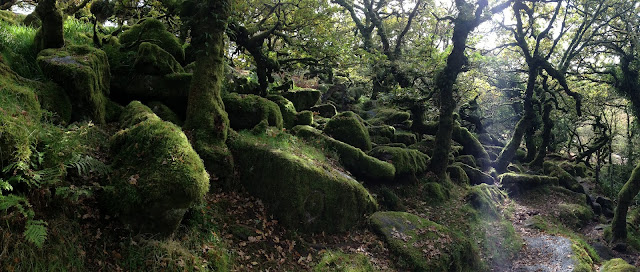Wistman's Wood is South West facing, but nestled in the valley of the West Dart River. It is protected from the worst of the weather that blasts the high altitude. The rocks, huge granite boulders, tumbled from the nearby Tor's, allowing rich soil to gather and maintain the Oak Woods for millennia.
 |
| You can just about see the woods - Top Middle. |
Basically, Wistman's wood is one of the oldest Oak Groves in Britain. It has an eerie atmosphere where you can imagine Yoda popping his head out.
I’ll admit it does feel odd to be entering an Oak grove, high on Dartmoor. I can understand why it has been enigmatic to artists and writers over the years.
Entering Wistman’s wood, the colour pallet changed from autumn yellows of the grassland to a deep mossy green, and Oak oasis teeming with woodland life (unusual on the moor).
Moss upon moss, upon moss. Many varieties can be found competing on every branch, even if the branch has long since perished.
Among the Oaks, a couple of Rowan trees and a Holly can be found, as well as their bright red berries littered across stone and green.
Strange mossy forms grow on the Oak branches, some of which are only held together by the moss itself.
Puffball full of spores, waiting for the popping
Coffin Rock
Every surface, crag or corner is packed full of interest. Cup Lichen grows alongside what I think are Petticoat Mottlegill mushrooms (Panaeolus papilionaceus)
Tumbled rocks are scattered through the oak woods, some curiously upright. Ancient man, Druids or Aliens?
Mossy tendrils
Some of the Oaks are thought to be 500 years old.
An example of Brown Roll Rim mushrooms, I think! (Paxillus involutus)
These 3 trees look like dancers.
A ferny wig for an old Ent.
What at first appears to be another large boulder, was revealed to be carved with text. Nothing ancient, this text has Serifs!
The Buller Stone, commemorates an attempt in 1866 to date the trees, when Wentworth Buller (with permission from the Duchy) felled an oak.
Amethyst deceiver mushroom
A brilliant autumnal day to be exploring the middle of Dartmoor. The grasses, in particular, looked vivid against the mix of storms clouds and blue sky.
Dartmoor Ponies dot the hillside, leading up to Longaford Tor.
There are few signs of industry, ancient or modern, up at Longaford Tor. As a natural outcrop, it has been crumbling and tumbling for millions of years. The hillside shows evidence of Bronze Age hut circles, meaning the Tor is likely to have been significant to the people who lived here 4000 years ago.
Where did all the rock in Wistman’s wood come from? Further up the slopes, the exposed Tor with the ‘Clitter’ beyond, scattered all the way down to the West Dart River


























